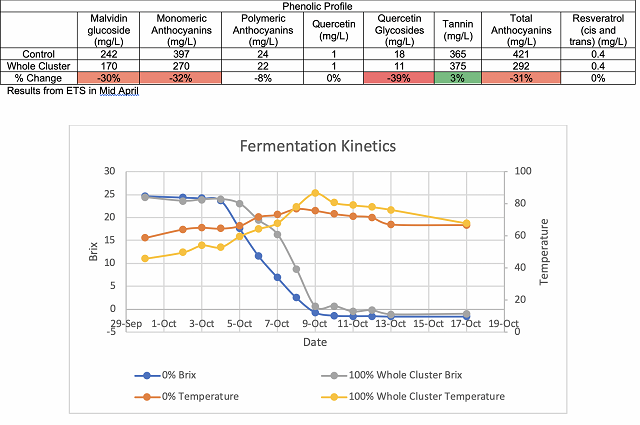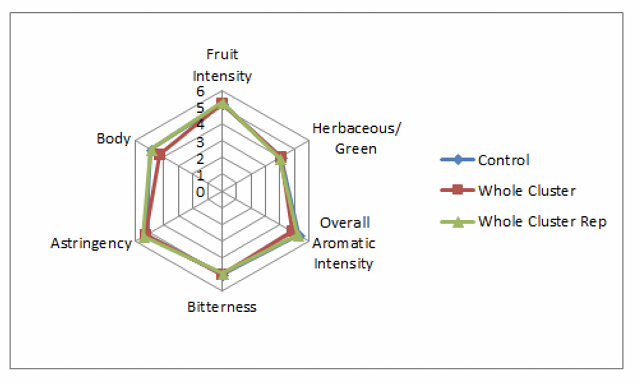Whole Cluster Inclusion in Cabernet Franc Fermentations (2017)
Ben Jordan and Maya Hood-White
Early Mountain Vineyards
Summary
This study examines the impact of whole cluster inclusion on Cabernet Franc wines. Cabernet Franc grapes were harvested and processed into T bins. One T bin received 100% destemmed grapes, and the other received 100% whole clusters. The destemmed treatment was punched down twice daily, and the whole cluster treatment was stomped. After 18 days of maceration, wines were pressed off. The whole cluster wine fermented slower than the destemmed wine. Ethanol content, potassium, and lactic acid were also higher in the whole cluster wine. Color and anthocyanin were lowered in the whole cluster wine, while catechin and gallic acid were increased. Tannin may have slightly increased in this wine as well, but this is a weak result. For the triangle test, of 26 people who answered, 11 people chose the correct wine (42%), suggesting that the wines were not significantly different. In general, people who answered correctly did not show strong preferences for one wine over the other. For the descriptive analysis, there were no strong trends for the descriptors used in this study.
Introduction
The role of whole cluster and stem inclusion in winemaking is very controversial. Whole cluster fermentation is often used in Burgundian Pinot noir and is thought to add complexity to the wine (Weston 2000). Whole clusters are thought to round out and complement the low tannin in Pinot noir, and the flavors of Syrah can be complemented by stems (Meisner 2016). However, whole cluster inclusion also results in stems being added to the wine. Stems can enhance structure and wine quality sometimes, but also can add vegetal aromas (Ribèreau-Gayon et al. 2006). In certain cases, these vegetal aromas can also be perceived as spicy, and may act as a counterbalance to overly fruity qualities. Vegetal aromas and tannin additions may also balance out some carbonic maceration character which is found in whole cluster inclusion, which enhances ester aromatics, extends fermentation after pressing, and reduces the contribution of seed tannin. Stem inclusion is less common for Bordeaux varieties because of their already high levels of pyrazine (Meisner 2016). The reticence to use stems due to pyrazine characteristics in certain varieties is likely unfounded, due to cultural practices and climatic conditions which can greatly lower pyrazine character. Stems tend to lower alcohol content, decrease titratable acidity, and increase pH (due to high potassium levels). Stems can contribute a large amount of tannin to wine. Additionally, stems tend to decrease color intensity by adsorbing anthocyanins (Ribèreau-Gayon et al. 2006; Reshef et al. 2016). Finally, wines made with stem inclusion tend to have higher color stability over time (Ribèreau-Gayon et al. 2006). These results vary, however (Ribèreau-Gayon et al. 2006), and are dependent on many other factors, such as extraction kinetics, maceration practices, the level of crushing in the grapes, grape variety, and possibly stem maturity. Whole cluster and stem inclusion require much more thorough study before any hard conclusions can be drawn. This study examines the impact of whole cluster inclusion on Cabernet Franc wine.
Results and Discussion
The whole cluster wine fermented slower than the destemmed wine. Ethanol content, potassium, and lactic acid were also higher in the whole cluster wine. Color and anthocyanin were lowered in the whole cluster wine, while catechin and gallic acid were increased. Tannin may have slightly increased in this wine as well, but this is a weak result. For the triangle test, of 26 people who answered, 11 people chose the correct wine (42%), suggesting that the wines were not significantly different. In general, people who answered correctly did not show strong preferences for one wine over the other. 5 judges preferred the control, 3 preferred the whole cluster, and 1 had no preference. For the descriptive analysis, there were no strong trends for the descriptors used in this study.



Methods
On September 29, 2017, Cabernet Franc grapes were harvested and processed into T bins. One T Bin received 100% destemmed grapes, whereas the other received 100% whole clusters. At crush, 40ppm sulfur dioxide was added. Must was not inoculated. The destemmed treatment was punched down twice daily, and the whole cluster bin was stomped daily. On October 17, both wines were pressed off, and only free run wine was used for this study. Malolactic conversion began (ambient) on October 30, and on this date 0.25g/L tartaric acid was added to the wine. On November 21, 0.05g/L Stab Micro and 60 ppm sulfur dioxide was added to the barrels. On December 7, 0.33g/L tartaric acid was added to each wine. On February 1, 10ppm sulfur dioxide was added.
This project was tasted on May 2. For the triangle test, descriptive analysis, and preference analysis, anybody who did not answer the form were removed from consideration for both triangle, degree of difference, and preference. Additionally, anybody who answered the triangle test incorrectly were removed from consideration for degree of difference and preference. Additionally, any data points for preference which did not make sense (such as a person ranking a wine and its replicate at most and least preferred, when they correctly guessed the odd wine) were removed.
In order to balance the data set to perform statistical analysis for descriptive analysis on the May 2 tasting, any judge who had not fully completed the descriptive analysis ratings were removed. In order to then make the number of judges between groups equivalent, one judge from group 3 was eliminated. This resulted in a final data set of 3 groups, each with 7 judges (considered as replications within groups, and groups were considered as assessors). Data was analyzed using Panel Check V1.4.2. Because this is not a truly statistical set-up, any results which are found to be statistically significant (p<0.05) will be denoted as a “strong trend” or a “strong tendency,” as opposed to general trends or tendencies. The statistical significance here will ignore any other significant effects or interactions which may confound the results (such as a statistically significant interaction of Judge x Wine confounding a significant result from Wine alone). The descriptors used in this study were Fruit Intensity, Herbaceous/Green, Overall Aromatic Intensity, Bitterness, Astringency, and Body.
References
Meisner, M. 2016. Fermentation 101: The case for whole clusters. Last Bottle. http://blog.lastbottlewines.com/education/whole-clusters/. Accessed 2/10/2017.
Reshef, N., Morata, A., and Suárez-Lepe, J.A. 2016. Towards the use of grapevine by-products for reducing the alcohol content of wines. Biointerface Research in applied Chemistry. 6:1531- 1537.
Ribèreau-Gayon, P., Dubourdieu, D., Donèche, B., and Lonvaud, A. 2006. Handbook of Enology, Volume 1: The Microbiology of Wine and Vinifications 2nd Edition. John Wiley & Sons. Chichester, West Sussex, England.
Weston, L.A. 2000. Grape and wine tannins and phenolics – their roles in flavor, quality and human health. 29th Annual New York Wine Industry Workshop. https://ecommons.cornell.edu/handle/1813/39812. Accessed 2/7/2017.
